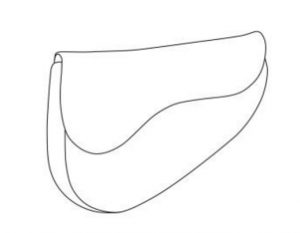BACKGROUND TO THE DISPUTE
On 24 March 2021, CHRISTIAN DIOR COUTURE filed for registration of the three-dimensional trade mark at the European Union Intellectual Property Office (EUIPO):

By decision of 11 November 2021, the examiner partially refused the application pursuant to Article 7(1)(b) of the EUTMR. The Office argues that the sector in question is characterised by a great variety of shapes, so that the mark applied for will be perceived as one of many, as well as its practical aspect for storing objects, and therefore cannot be considered as a distinctive mark.
On 7 January 2022, the applicant challenged the decision in its entirety, claiming that the mark applied for consists of a shape that breaks with the usual codes of the markets concerned, as well as evoking the image of a saddle.
Notwithstanding the above, the Second Board of Appeal dismissed the appeal. In essence, it found that the mark applied for did not deviate significantly from the norm in the sector and was therefore devoid of any distinctive character within the meaning of Article 7(1)(b) of the EUTMR.
DECISION OF THE SECOND BOARD OF APPEAL
First, the Board considers that, with the exception of the goods in Class 18 ‘Leather and imitations of leather; animal skins and hides’, which are aimed at a professional public, the other goods covered by the mark are aimed at the general consumer, with the result that the level of attention is average.
Furthermore, the Board takes into account not only the wide range of prices of the products in question, but also their marketing channels, which include supermarkets, and it is therefore understood that these products cannot be considered as a subset of articles of an exclusive nature as the applicant claims.
However, even assuming that consumer attention is above average, this cannot be understood as a determining factor in the legal criteria used to assess the distinctiveness of a sign.
It is well known that the products in question belong to a sector, leather goods, which is characterized by the multitude and abundance of forms to which the consumer is regularly exposed.
It is therefore understood that for a trade mark to fulfil its essential function, namely to indicate its commercial origin, the difference between the sign applied for and the norms or customs of the sector must be significant (12/02/2004, C-218/01, Perwoll, EU:C:2004:88, § 49).
In application of the foregoing, the Board considers that the mark applied for consists of a combination of presentational elements typical of the goods in question and therefore does not deviate significantly from the usual norm or standard in the leather goods sector. Furthermore, the Board states that the presence or absence of a shoulder strap or handles, the slightly different shape of the flap, and the rectangular or rounded shape are not ‘significant’ for the consumer.
Finally, the fact that the goods are well designed does not necessarily imply that a mark consisting of the shape of those goods is capable of distinguishing them from those of other undertakings within the meaning of Article 7(1)(b) of Regulation 2017/1001 (05/02/2020, T-573/18, FORM EINES SCHNÜRSENKELS (3D), EU:T:2020:32, § 65).
From the foregoing, the Board finds that the examiner was right to refuse registration of the mark applied for on the ground of lack of distinctive character under Article 7(1)(b) of the EUTMR for the goods ‘bags; handbags; bags (leather goods), travel bags (leather goods), toiletry and make-up bags (empty)’.
JUDGMENT OF THE SECOND BOARD OF APPEAL, DATED 7 SEPTEMBER 2022. CASE R0032/2022-2


 Español
Español Deutsch
Deutsch